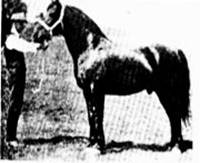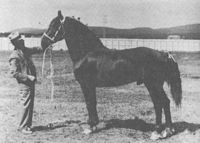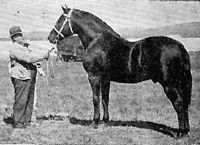|
|
|
Many thanks to Gladys M Beattie for permission to use photos from her book, "The Canadian Horse: A Pictorial History". We highly recommend this book to anyone interested in the breed. It is available thru CHARMD http://www.canadianhorsebreeders.com
 |
 |
SIRE LINES
Albert de Cap Rouge (Wilfrid x Helene) black stallion foaled May, 1913. This foundation stallion supreme was bred by M. Arsene Denis, one of the first directors and members of the Executive Commitee of the Canadian Horse Breeders Association. Albert's dam, Helene #49, was purchased for the foundation herd of the first government farm dedicated to reviving the best of the old French Canadian Horse at Cap Rouge. Helene was exactly the kind of mare that Cap Rouge was looking for. She had elegance, type, and spirit, and at just over 15 hands and barely 1000 lbs., she could easily do the work of a 1500 lb. horse with energy to spare. |
|
|
 |
Her son, Albert, proved to be everything that Cap Rouge had hoped for. Not only was he a superior horse himself, but had the ability to consistently pass on his best qualties to his offspring. Albert remained senior sire at Cap Rouge for almost two decades. He is the progenitor of the Brio, Becancour, Henryville, La Gorgendiere Royal, Major, and Pitro lines.
|
|
 |
 |
Prince III #2217 (Marquis x Frivole). This dark chestnut stallion of very old foundation stock is descended from Duc de Montcalm. He was bred by the Sylvestre family, and foaled in May 1929. His sire, Marquis, left only one other purebred foal, Datura 2eme. She produced Brunette #3290, dam of breed matriarch, Brunette 3eme. Prince III was Grand Champion stallion at the Quebec Exhibition in 1936. Although Prince III left only a few purebred foals, his influence as a sire should not be overlooked. |
|
 |
 |
Prince III is most represented in direct sire line through his son from Madeline de Cap Rouge, Thomas #2334 (pictured at left). Thomas was Reserve Grand Champion at the Quebec Exhibition in 1941. He sired Thomas de Viger, one of the eight designated line sires, who in turn sired several outstanding individuals, including Arnoldwold Viger and Tonka Wonka. Thomas also sired St. Anne Hisola, dam of line sire St. Anne Marquis de Becancour. Prince III is represented in the Henryville line through Prince Black #3554, and was grandsire to both sire and dam of Henryville Prince.
|
|
 |
 |
Lou #3613 (Deland de Cap Rouge x Mona). This bright chestnut stallion foaled in May, 1955, is also of very old foundation breeding. He traces back in direct sire-line to the grey stallion, Beau de Repentigny #200. Lou's sire Deland, was by Tom #2227, a notable sire at the 500 acre St. Joachim farm near Quebec City. The St. Joachim farm operated from 1919 to December, 1940 and incorporated the bloodlines of private breeders in to the breed conservation program. It housed more than 70 horses of breeding age, the biggest number in Quebec.
Lou is fairly well-represented in modern pedigrees through his daughters, but lives on in direct sire line only through his son, Bienvenue Lou Heros, another outstanding son of Brunette 3eme.
|
|
 |
 |
While there are many outstanding sires among the descendants of Albert de Cap Rouge, the stallion Albert de St. Isidore deserves special mention. Albert de St. Isidore appears prominently, often in the maternal grandsire position, in the pedigrees of historically noteworthy Canadian Horses. Among others, he was the sire of Pitro, Brunette 3eme, and of La Gorgendiere Reine (dam of line sires LG Royal and LG Major). Albert de St. Isidore (pictured left) was sired by Prince Champoux out of Beaute de Charlemagne. His bloodlines included some of the oldest stock, going back to foundation horses in the first registry.
|
|
 |
 |
Prince Champoux (Baron II x Sara de L'Acadie)
black stallion, foaled in 1932. Sire of Albert de St. Isadore
|
|
|
 |
|
|
|